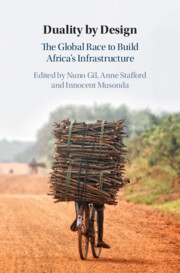Book contents
- Reviews
- Duality by Design
- Duality by Design
- Copyright page
- Contents
- Figures
- Tables
- Contributors
- Foreword
- Acknowledgements
- 1 Duality by Design: The Global Race to Build Africa’s Infrastructure
- Part I Mitigating Institutional Voids by Design
- 2 Why the Lights Went Out: A Capability Perspective on the Unintended Consequences of Sector Reform Processes
- 3 When the Quest for Electricity Reform and the Need for Investment Collide: South Africa, 1998–2004
- 4 Institutional Enablers of Energy System Transition: Lessons from Solar Photovoltaic Electricity in Eight African Countries
- 5 Harnessing Africa’s Energy Resources through Regional Infrastructure Projects
- 6 Centralized vs. Decentralized Generation in Zambia: Meeting Electricity Demand in the Context of Climate Change
- 7 Delivering Healthcare Infrastructure and Services through Public–Private Partnerships: The Lesotho Case
- 8 Achieving Long-Term Financial Sustainability in African Infrastructure Projects
- 9 A Proactive Social Infrastructure Model for Future Mixed-Use Housing in Egypt
- 10 Collective Action under the Shadow of Contractual Governance: The Case of a Participatory Approach to Upgrade Cairo’s ‘Garbage Cities’
- Part II Exploiting Institutional Voids by Design
- Afterword
- Index
- References
9 - A Proactive Social Infrastructure Model for Future Mixed-Use Housing in Egypt
from Part I - Mitigating Institutional Voids by Design
Published online by Cambridge University Press: 14 November 2019
- Reviews
- Duality by Design
- Duality by Design
- Copyright page
- Contents
- Figures
- Tables
- Contributors
- Foreword
- Acknowledgements
- 1 Duality by Design: The Global Race to Build Africa’s Infrastructure
- Part I Mitigating Institutional Voids by Design
- 2 Why the Lights Went Out: A Capability Perspective on the Unintended Consequences of Sector Reform Processes
- 3 When the Quest for Electricity Reform and the Need for Investment Collide: South Africa, 1998–2004
- 4 Institutional Enablers of Energy System Transition: Lessons from Solar Photovoltaic Electricity in Eight African Countries
- 5 Harnessing Africa’s Energy Resources through Regional Infrastructure Projects
- 6 Centralized vs. Decentralized Generation in Zambia: Meeting Electricity Demand in the Context of Climate Change
- 7 Delivering Healthcare Infrastructure and Services through Public–Private Partnerships: The Lesotho Case
- 8 Achieving Long-Term Financial Sustainability in African Infrastructure Projects
- 9 A Proactive Social Infrastructure Model for Future Mixed-Use Housing in Egypt
- 10 Collective Action under the Shadow of Contractual Governance: The Case of a Participatory Approach to Upgrade Cairo’s ‘Garbage Cities’
- Part II Exploiting Institutional Voids by Design
- Afterword
- Index
- References
Summary
Egypt’s population of 96 million is expected to double within the next twenty to thirty years. Given that Egypt has failed to meet a continuous increase in housing demand since the 1950s, there has been an expansion of informal housing, informal adaptation of formal housing and informal mixing of residential and non-residential uses. Whilst informal interventions may allow better access to affordable housing, they do not abide by building codes or regulations; thus, they burden existing infrastructure, and negatively affect the physical and psychological well-being of society.
This chapter investigates the potential for a dynamic response to a society’s changing housing needs. A case study in an informal area of the Greater Cairo Region (GCR) sought to define means of informal interventions in order to capitalize on lessons learned, and to inform future mainstream housing developments in Egypt.
It concludes that a proactive flexible and adaptable mixed-use housing model may help respond to the socio-economic and demographic dynamics of households. However, the compatibility of non-residential activities requires investigation, and any necessary measures taken before mixing with residential. This model also anticipates a reduction in commuting, which would alleviate traffic congestion and strengthen community ties.
- Type
- Chapter
- Information
- Duality by DesignThe Global Race to Build Africa's Infrastructure, pp. 254 - 283Publisher: Cambridge University PressPrint publication year: 2019

